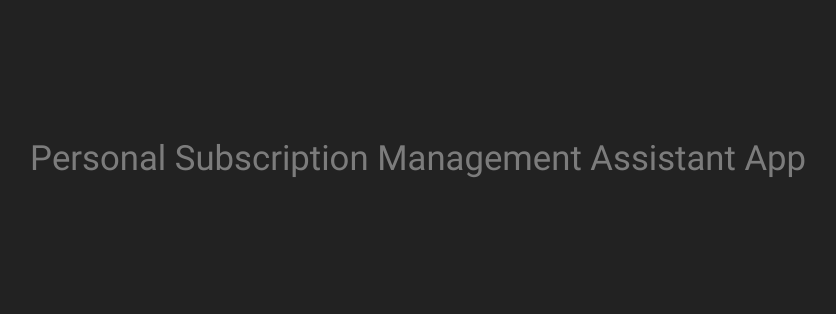In today’s competitive app market, finding a profitable niche with low competition is key to creating a successful mobile app. This article explores innovative app ideas that promise high earnings potential with fewer competitors, giving you a head start in 2025's booming digital landscape.
Personal Subscription Management Assistant App


Overview: Managing subscriptions has become a real hassle, especially as people sign up for more and more services – from streaming platforms and software tools to fitness apps and meal kits. The Personal Subscription Management Assistant (PSMA) is here to simplify things by giving users an easy, powerful way to track, manage, and make the most out of all their subscriptions in one place.
Problem It Solves: Subscription fatigue is a common issue nowadays. Many people end up paying for services they no longer use, often because they forget they're even subscribed. On top of that, different billing cycles and complicated cancellation processes make managing subscriptions a real pain. PSMA tackles these problems by bringing all subscriptions together in one easy-to-use app, making it simple to track, adjust, or cancel any subscription.
Key Features:
-
Centralized Dashboard: A clear, user-friendly view of all active subscriptions, with monthly and annual cost summaries to help avoid surprises.
-
Smart Notifications: Timely reminders before renewals, so users can decide whether they want to continue or cancel – all from within the app.
-
Easy Cancellation and Management: Makes managing subscriptions hassle-free, with direct links and automated support to help cancel or modify services.
-
Spending Insights: Gives a clear picture of how much is being spent on subscriptions, helping users identify which services are worth keeping and which aren’t.
-
Trial Tracking: Tracks free trials and sends reminders before they end, so users don’t get caught with unexpected charges.
-
Security and Privacy: Keeps user data safe with top-notch encryption, ensuring payment details and subscription info are secure.
-
Group Subscription Splitting: Makes it easy to share subscription costs for services like Netflix or Spotify by helping track expenses and send reminders to everyone involved.
Target Audience: PSMA is for anyone who has multiple subscriptions and wants to save money and avoid hassle. Whether it’s Millennials, Gen Z, busy professionals, or families, PSMA is all about making subscription management simpler and more cost-effective.
Monetization Strategy:
- Freemium Model: Core features are free, with advanced options like detailed spending analytics and automated cancellation available through a premium subscription.
- Affiliate Revenue: Partnerships with subscription services allow the app to earn commissions when users sign up through PSMA.
- Savings Insights Subscription: An optional subscription that provides personalized spending tips and automated cost-saving suggestions.
Unique Selling Point (USP): What sets PSMA apart is its focus on simplicity and giving users real control. It doesn’t just track subscriptions – it actively helps reduce costs, manage renewals, and simplify shared expenses. Features like trial tracking and subscription splitting add extra convenience that other apps don’t usually provide.
Growth Potential: As the number of subscription services keeps growing, more people are looking for ways to cut unnecessary spending. PSMA can help users save hundreds of dollars a year by offering effective subscription management. This not only provides real financial benefits but also means strong potential for user growth and loyalty.
Future Features to Explore:
- Negotiation Assistance: Partnering with services like Trim to help users get better rates on existing subscriptions.
- AI-Driven Suggestions: Using AI to analyze user habits and preferences, suggesting cheaper alternatives or pointing out underutilized subscriptions.
- Family and Group Management: Expanding features for family plans to make it easy to monitor shared subscriptions and split costs, ensuring everything stays transparent and simple for everyone.
Mindful Parenting Companion


Description
This app targets the growing market of mindful, conscious parenting by offering resources, tools, and support for parents raising children in a balanced, emotionally supportive way. Unlike standard parenting apps that focus on developmental milestones and basic parenting tips, this app would dive deep into aspects like emotional intelligence, mindful communication, and mental well-being for both parents and children. It could include guided activities, parenting courses, community discussions, and professional consultations, all tailored to help parents raise emotionally resilient children.
Why This App Stands Out
Mindful parenting has gained significant popularity, particularly in the U.S., as more parents look for ways to foster emotional intelligence and mindfulness in their families. However, while there’s a surge of interest, few apps cater to this niche. Most parenting apps are limited to tracking milestones or scheduling doctor’s visits. This app could fill a critical gap by offering content that supports emotional health and mindful practices for both parents and children.
Key Features
- Guided Activities: Exercises in mindful breathing, stress relief, and communication, geared toward both parents and children.
- Expert-Led Content: Courses and articles written by child psychologists, mindfulness teachers, and family therapists.
- Parenting Journal: A private journal space where parents can reflect on parenting challenges, track emotional progress, and set family goals.
- Community Support: A safe, moderated space for parents to share experiences, ask questions, and receive support from a like-minded community.
- Mental Health Check-Ins: Tools for checking in on both parent and child emotions, offering insights and advice when stress levels are high.
Monetization Strategy
- Subscription-Based Model: A free version can include basic features like community access and a limited number of activities, while a premium subscription unlocks expert-led courses, full access to content, and live sessions with family therapists.
- One-Time Purchases: Parents could buy standalone content packs, such as a “Mindful Morning Routines” series or “Handling Tantrums with Calm” mini-course.
- Sponsored Partnerships: Collaborations with child-friendly brands, wellness products, and even publishers of children’s mindfulness books could be a valuable revenue stream.
- Ad-Free Premium Option: Provide an ad-free experience for premium subscribers, ensuring the app aligns with the mindful approach it promotes.
Marketing & Promotion
- Influencer Marketing: Collaborate with popular mindful parenting influencers on Instagram and YouTube who can promote the app through authentic content and testimonials.
- Cross-Promotion with Parenting Blogs: Reach out to mindful parenting blogs and family wellness websites for guest content, partnerships, or affiliate opportunities.
- In-App Referral Program: Encourage users to invite friends by offering them and their friends access to exclusive content when they refer others.
- Email Campaigns: Targeted email campaigns that provide valuable free content (e.g., a downloadable “Mindful Parenting Tips” PDF) can attract interested subscribers.
Market Potential
With an increasing emphasis on mental health and emotional intelligence, the market potential is vast, particularly among Millennial and Gen Z parents who prioritize a more conscious approach to parenting. Mindful parenting is a strong and relatively underserved niche, and this app can become an essential tool for parents committed to nurturing their children’s mental and emotional well-being.
Growth Potential
The app has strong expansion possibilities, such as adding live workshops, multilingual support, and content for different age groups. As mindfulness becomes a central focus in modern parenting, this app can build a loyal user base that sees it as a crucial support system.
iOS or Android First?
Launching on iOS first could be advantageous due to the platform’s high-income demographics in the U.S., which align well with an audience likely to pay for premium wellness-focused content. Additionally, iOS users in this segment often spend more on apps, especially for family and self-improvement tools.
Offline Travel & Adventure Companion


Description
This app caters to travelers, campers, hikers, and adventure seekers by providing offline access to essential information, such as hiking trails, camping spots, survival tips, weather alerts, and even an emergency contact feature. With a particular focus on those venturing into areas with poor internet coverage, this app can offer interactive maps, route planning, wildlife spotting guides, and more, all available offline.
Advantages
- Niche Market: This app appeals to a specific group of users—outdoor enthusiasts—who often face connectivity challenges in remote locations. There’s growing interest in outdoor activities, especially in the U.S. and other developed countries, which increases demand.
- Low Competition: While there are many travel apps, few focus on offline functionality or provide comprehensive support for wilderness survival.
- Recurring Usage: Once downloaded, users are likely to continue using the app for multiple trips, hikes, or camping trips, especially if the app proves reliable and informative.
Disadvantages
- Limited Appeal: The app might have a limited market appeal, as it primarily targets adventure and outdoor enthusiasts.
- Data Requirements: Offering offline maps and guides requires a substantial amount of data storage, which can increase development costs and may impact app performance.
- Maintenance Needs: The app will need regular updates to keep trail maps and safety information accurate and relevant.
Monetization Options
- Subscription Model: Offer a free basic version that includes a few essential maps and features, with a premium subscription unlocking additional maps, wildlife spotting guides, weather alerts, and emergency tools.
- In-App Purchases: Allow users to purchase specific maps, trail guides, or regional content packs. This can be especially attractive for users who travel to different locations.
- Affiliate Marketing: Partner with outdoor brands (such as gear, equipment, and travel insurance providers) for affiliate revenue. Recommendations could also be embedded in the app’s content, like “Best Equipment for Desert Hiking.”
- Data Licensing: For popular hiking spots, consider licensing data to tourism boards or travel companies interested in promoting safe exploration.
Marketing Strategies
- Content Marketing: Create a blog or video series that provides adventure tips, outdoor safety guides, and location-specific advice to draw in the target audience.
- Partnerships with Adventure Influencers: Partner with popular adventure travel influencers on Instagram or YouTube who can promote the app as a must-have for safe, offline exploration.
- Community Engagement: Include a feature that allows users to submit their own trail ratings, photos, and reviews, creating a user-generated content loop that keeps the app relevant.
- Outdoor Retail Partnerships: Collaborate with outdoor gear shops and camping supply stores to offer exclusive in-app discounts, advertised in-store.
Market Potential
The outdoor and adventure travel market in the U.S. alone is substantial, with millions of people engaging in activities like hiking, camping, and biking each year. The post-pandemic interest in outdoor experiences has only increased, making the potential for such an app even stronger. A focus on offline functionality offers unique value that traditional travel apps don’t provide.
Key Competitors
- AllTrails: While AllTrails offers hiking and trail information, it’s primarily online-focused, and its offline mode has limited functionality.
- Gaia GPS: Known for mapping features, but it’s more focused on GPS tracking than providing holistic travel and adventure support.
- Komoot: A mapping app for hikers and cyclists, though it lacks survival guides or emergency features.
Growth Potential
This app has strong growth potential, especially among nature lovers, backpackers, and even solo travelers who prioritize safety and preparedness. By continuously adding new trails, survival tips, and support for more locations, the app can expand globally. Unique features like interactive wildlife spotting or an emergency beacon function can set it apart from standard travel apps.
iOS or Android First?
- iOS: iOS users, particularly in the U.S., are more likely to invest in high-quality, reliable tools for outdoor adventures. They may also be more receptive to paying for premium offline functionality.
- Android: Given Android’s dominance in global markets, especially in countries with extensive outdoor tourism like Canada, Australia, and various parts of Europe, an Android launch could maximize initial reach.
For an initial launch, iOS might be preferable if the app is first targeting the U.S. outdoor enthusiast market, which includes a strong segment of high-income users likely to pay for premium features.
Pet Health & Wellness Tracker


Description
This app focuses on pet health, wellness, and lifestyle tracking. It can allow pet owners to log vet visits, vaccination schedules, dietary preferences, exercise routines, and even mood changes. Using AI, the app can provide health insights and alerts based on the data, offering reminders for vaccinations, and suggesting health tips, feeding routines, or exercise plans tailored to each pet's age, breed, and medical history.
Advantages
- Growing Market: The pet care market is booming, especially in the U.S., as more people consider pets part of the family. A health tracker for pets is both practical and innovative, filling a niche that’s in high demand.
- High Engagement: Pet owners tend to be passionate and engaged, especially when it involves caring for their pets.
- Value-Added Feature: The app could integrate telehealth options, allowing pet owners to have virtual consultations with vets directly through the app.
Disadvantages
- High Development Cost: Integrating AI for health insights, telehealth services, and possibly a wearable device integration (for pet fitness tracking) may increase the initial development cost.
- Compliance & Liability: Health-related apps, even for pets, need to ensure data privacy and can face liability concerns, especially if medical advice is given.
Monetization Options
- Subscription Model: Offer a free basic version that tracks vaccinations and provides reminders, while a premium version includes additional health insights, customized wellness plans, and 24/7 access to a virtual vet.
- In-App Purchases: Offer purchases such as diet plans, fitness programs, or breed-specific wellness guides.
- Affiliate Partnerships: Partner with pet care brands (such as food, grooming products, and pet insurance providers) for referral revenue.
- Sponsored Content: Collaborate with pet wellness brands to feature sponsored content, such as new products or services, within the app.
Marketing Strategies
- Influencer Marketing: Partner with pet influencers on platforms like Instagram and TikTok to promote the app to a pet-loving audience.
- Community Building: Include a social feature where pet owners can share their pets’ health journey, swap tips, and connect with local pet communities. This will foster engagement and help spread word-of-mouth.
- Content Marketing: Launch a blog or video series on topics like “Pet Nutrition 101” or “Exercising with Your Dog,” attracting users through educational content.
- Pet Store Partnerships: Partner with pet stores and veterinary clinics to promote the app as a tool to support pet health, with in-store displays and QR codes linking to app downloads.
Market Potential
The pet care market in the U.S. is worth over $100 billion, with a growing segment focused on pet wellness. This app targets a subset of highly engaged, loyal consumers who spend on pet care and wellness. The app has international scalability, as similar pet care trends are growing worldwide, especially in Europe, Australia, and Canada.
Key Competitors
- PetDesk: A pet care app that focuses on scheduling and medication reminders but lacks comprehensive wellness and health insights.
- Pawtrack: A pet GPS and health tracking app, primarily focused on pet location tracking rather than wellness.
- Whistle: Known for its GPS tracker, Whistle offers some wellness insights for pet owners but doesn’t provide detailed, customized health plans.
Growth Potential
There’s significant growth potential here as more people are willing to invest in their pets' health and well-being. Integrating a feature like telehealth or a wearable device could make the app even more appealing and establish it as a must-have tool for pet owners. As a first-mover in comprehensive pet health and wellness tracking with AI, this app can become a staple in the pet care industry.
iOS or Android First?
- iOS: iOS users tend to spend more on apps, and pet owners on this platform may be more willing to pay for a premium service. The demographics align well with a consumer base likely to invest in pet wellness apps.
- Android: If the target is a broader international market or pet owners in emerging markets, launching on Android can maximize reach due to Android's global user base.
For a U.S.-focused launch, starting with iOS is recommended, given the spending power of iOS users and the pet owner's profile likely to subscribe to a wellness app.
Personal Finance & Budgeting App with AI Insights


Description
A personal finance app that not only tracks expenses but also uses AI to provide personalized financial insights, spending forecasts, and savings suggestions. The app could also offer goal-setting features, investment education, and budgeting tools designed for different user types, from college students to families.
Advantages
- High Demand: Budgeting and finance apps are increasingly popular, especially as people focus on financial literacy and debt management.
- Retention Potential: Users are likely to use the app regularly if it helps them save money or reach financial goals.
- Scalability: The app can expand to include advanced features, such as investment tracking, tax optimization, or debt management.
Disadvantages
- Complexity of Development: Integrating AI and secure financial data storage requires skilled development and additional resources.
- Compliance: Handling financial data may require adhering to strict regulations (such as GDPR, CCPA) and ensuring data security.
- Competition: There are popular players in this space, though most lack the AI-driven personalized insights that could set this app apart.
Monetization Options
- Freemium Model: Offer basic budgeting tools for free, with premium features (like AI insights, advanced analytics, and financial advice) available via subscription.
- Advertisements: Show targeted ads based on spending behavior, but only if they don’t compromise user experience.
- Affiliate Marketing: Partner with financial service providers (credit cards, loans, investment platforms) to earn referral fees.
- Data Insights for Financial Institutions: Offer anonymized spending insights to banks and financial institutions for a fee.
Marketing Strategies
- Content Marketing: Launch a blog with tips on saving, budgeting, and investing to attract an audience interested in finance.
- Influencer Partnerships: Collaborate with personal finance influencers to gain credibility and reach a wider audience.
- Social Media Advertising: Run ads on Facebook, Instagram, and TikTok targeting young professionals and families interested in budgeting.
- App Store Optimization (ASO): Optimize the app listing with high-demand keywords and positive user testimonials to improve visibility in app stores.
Market Potential
The personal finance app market is substantial, with the global market size valued at over $1 billion and projected to grow as financial literacy becomes a priority for many people. The U.S. market, in particular, shows high engagement with these apps, especially among younger users and professionals.
Key Competitors
- Mint: A popular budgeting app with basic expense tracking but limited AI-driven insights.
- YNAB (You Need a Budget): Known for its budgeting framework but with a steeper learning curve.
- PocketGuard: A straightforward budgeting app, though lacking in comprehensive financial planning features.
Growth Potential
The AI-driven insights feature can set this app apart, making it appealing to users seeking more than simple expense tracking. The personalization aspect aligns well with users’ demands for smarter tools that help them make informed decisions.
iOS or Android First?
- iOS: iOS users in the U.S. typically spend more on apps, and Apple offers strong tools for building secure, high-performance finance apps.
- Android: If targeting a global market, launching on Android may be beneficial due to its larger market share worldwide.
For a U.S.-focused launch, iOS may be the better choice initially, as it aligns with high-income demographics likely to pay for financial planning tools.
Developing a mobile app that combines profitability with low competition can set you up for long-term success. By choosing the right niche, you’ll not only meet market demand but also carve out a unique space in the industry. Explore these ideas to maximize your app’s earning potential and make a strong entry into the market.
